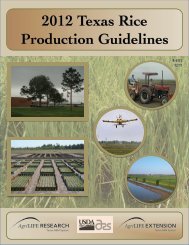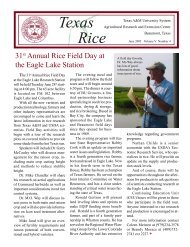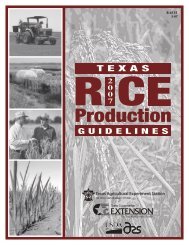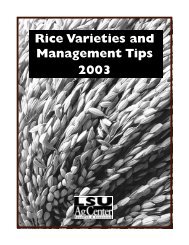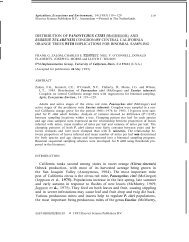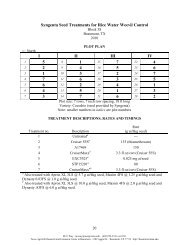Evaluating Potential Rice Varieties from University and Industry ...
Evaluating Potential Rice Varieties from University and Industry ...
Evaluating Potential Rice Varieties from University and Industry ...
Create successful ePaper yourself
Turn your PDF publications into a flip-book with our unique Google optimized e-Paper software.
EXECUTIVE SUMMARY (cont.)<br />
The highest ratoon yielders at Beaumont were the hybrids yielding between 5000 <strong>and</strong> 3400 lbs/A.<br />
Highest average ratoon yields of conventional varieties were TX9092 (3900 lbs/A) followed by<br />
Saber (3200 lbs/A) <strong>and</strong> Bengal (3800 lbs/A). Cocodrie, Cheniere <strong>and</strong> Francis yield only 2200<br />
lbs/A each.<br />
Highest total crop yields (11,000 to 13,000 lbs/A) were produced by hybrids. The highest total crop<br />
yield for conventional varieties were TX9092 (10,800 lbs/A) <strong>and</strong> Cocodrie <strong>and</strong> Cheniere at 9400<br />
lbs/A.<br />
Page 8 of the executive summary gives main crop (MC), ratoon crop (RC) <strong>and</strong> total crop (TC)<br />
economic ranking which is better than yield as a variety evaluator.<br />
Eagle Lake location<br />
See Figures 4-A,4-B <strong>and</strong> 4-C, pgs. 36-38<br />
At Eagle Lake the new experimental hybrid XP710<br />
gave the highest main crop yield (9800 lbs/A) followed<br />
by XL8 <strong>and</strong> CLXL8 (8700 lbs/A), XP712 (8600 lbs/A)<br />
<strong>and</strong> XL7 (8100 lbs/A). Average main crop yield of<br />
conventional varieties were Cocodrie<br />
(8300 lbs/A) followed by TX9092, Francis, Jefferson <strong>and</strong> Bengal (8000 lbs/A), Cheniere (7900<br />
lbs/A), CL161 (7700 lbs/A) <strong>and</strong> TX8181 with 7100 lbs/A.<br />
Most ratoon yields at Eagle Lake were less than normal, with hybrids averaging about 4000 lbs/A<br />
<strong>and</strong> conventional varieties averaging only 2000 lbs/A except for Francis with 1100 lbs/A.<br />
Maximum total yields were between 12,000 <strong>and</strong> 13,000 lbs/A for hybrids <strong>and</strong> TX9092 followed by<br />
Bengal <strong>and</strong> CL161 (10,000 lbs/A), Cocodrie (9800 lbs/A), Cheniere <strong>and</strong> Jefferson (9600 lbs/A),<br />
with TX8181 <strong>and</strong> Francis at about 9000 lbs/A.<br />
3) Plant population <strong>and</strong> N rate effects on main crop <strong>and</strong> ratoon crop yield<br />
Figures 3-A, 3-B, <strong>and</strong> 3-C (Beaumont) <strong>and</strong> 4-A, 4-B, <strong>and</strong> 4C (Eagle Lake) show the main <strong>and</strong><br />
ratoon yields of each variety at the two achieved plant populations (seedlings/ft 2 ) <strong>and</strong> two N rates<br />
shown in the figures. The desired or “targeted” seedlings/ft 2 were 12 <strong>and</strong> 24 for the conventional<br />
varieties <strong>and</strong> 9 <strong>and</strong> 18 for the hybrids as shown in Table 1-B along with the seeding rates we used<br />
to obtain the measured seedlings/ft 2 .<br />
Figures 3-A, 3-B <strong>and</strong> 3-C show that under the 2003 conditions at<br />
Beaumont location Beaumont, maximum main <strong>and</strong> ratoon crop yields were obtained with the<br />
higher N rate (180 lbsN/A for hybrids <strong>and</strong> 220 lbs N/A for the conventional<br />
varieties) possibly because the soil N supply was lower than usual. These<br />
data illustrate that lower than recommended plant population (9 seedlings/ft 2 for hybrids <strong>and</strong> 15<br />
seedlings/ft 2 for conventional varieties) can produce maximum yields provided the seedlings are<br />
uniformly distributed, varieties have high tillering capacity well, <strong>and</strong> field conditions do not inhibit<br />
tillering <strong>and</strong> additional N is added.<br />
6



